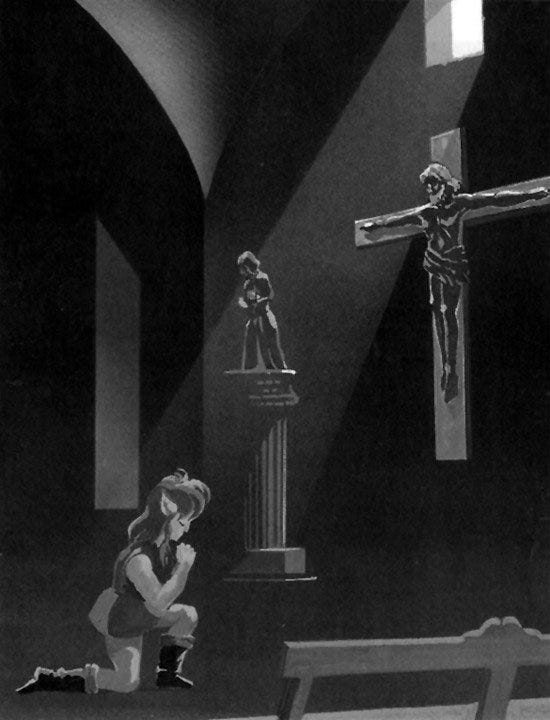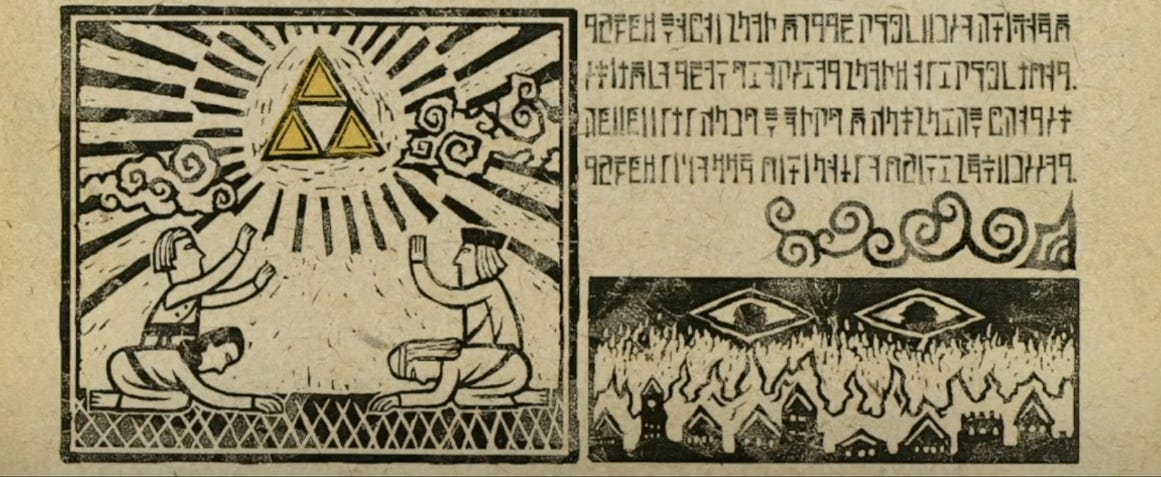Nintendo's Link to the Masonic Past
A glimpse into the esoteric symbology of the Zelda franchise
While Nintendo and its game designer, Shigeru Miyamoto, have captivated the world of gaming for decades, there is a lesser-known fact about their origins that adds to their mysterious allure - their roots in the occult. It is said that Nintendo's original president, Hiroshi Yamauchi, had an interest in esoteric practices and employed a psychic consultant to help with business decisions. Additionally, the iconic character of Mario is said to have been inspired by a 16th-century Italian occultist named Mario de' Fiori.
From the very start of the company, Nintendo's Hanafuda style playing cards, made popular by Yakuza gambling, were originally brought to Japan by Portugese Jesuits and later became a localized version of Western playing cards. Miyamoto's creation of Devil World, a 1984 game only released in Japan for the Famicom, adds to the intrigue surrounding the video game creator. The game was rejected by Nintendo America due to its heavy use of religious and Satanic imagery.
Perhaps one of the earliest visible examples of Masonic symbolism in a Nintendo game can be seen in the 1988 game Super Mario Bros. 3, World 5-1 (Sky Land) which features a collection of coins that spell out the number 33 for no apparent reason other than a “hidden in plain sight” moment.
In the realm of MKUltra research, one prevalent theme is the use of Alice in Wonderland symbolism. Rabbits, mushrooms and checkerboards, for example, are symbols frequently used in Illuminati and MKUltra references. These same symbols can also be found in the Mario and Zelda games, both of which were created by Miyamoto. The Temple of Time in Ocarina of Time and the castle in Mario 64 both feature checkerboard floor designs, remarkably similar to those found in Masonic temples.
For more on the plethora of masonic symbolism in Mario 64, refer to to Owen Cyclops' Twitter thread which goes into greater detail.
In “A Link to the Past”, Link was intended to be Christian. But the cross and Bible were swapped for mystery school symbols such as the Triforce, Masonic eagles, Horus falcons/hawks, Cancer lobsters, and magic books. The Triforce is perhaps the most famous of these symbols, and it represents two lower dualities ascending as one. The Triforce is made up of equilateral triangles, which can also be made with the vesica pisces. However, the claimed Hojo clan source is a squat, non-equilateral triangle. Additionally, Tal Tal Mountain is a step pyramid with a "world egg" on top.
Link himself also has symbolic significance. Link can be interpreted as "linking your dualities," representing the journey towards unity and wholeness. The color green, which is the color of Horus's eye, is also significant in the game. Link's hat is shaped like child Horus's lock of hair.
Additionally, there are various recurring symbols throughout the Zelda franchise such as the volcano which is a symbol of Vulcan/Tubal Cain, and the Goron forges a mighty sword like Tubal Cain. The various bodies of water in the games, such as Hyrule Lake and later the Oceans, represent Enki/Ea. The Hylians, the race to which Link belongs, are actually Hylics, a term from Gnosticism that refers to materialistic people who are ignorant of spiritual matters. The Temple of Time is actually a reference to the Temple of Saturn, and Rauru, the builder of the Second Temple, is similar to Cyrus the Great.
While Majora's Mask has a cult following, it is also appropriately known for its dark themes and occult symbolism. The game is said to retell the story of Mozart's famous opera "The Magic Flute", where Link is Tamino, Majora is the Queen of the Night, and Skull Kid is Sarastro. For those wondering what's so esoteric about a game being a retelling of an operatic masterpiece, it’s that Mozart's Magic Flute is known to be a "masonic opera." The Queen represents the Austrian empress Maria Theresa who oppressed Masonic Lodges. The High Priest Sarastro represents Ignaz von Born, leader of the Vienna Masonic Lodge of which Mozart was a member. "Tamino and Pamina finding pure love and enduring the Masonic trials of self-discipline through silence. They are ultimately purified by the basic elements of fire and water. Once they have successfully gone through these trials, Sarastro gives them the shield of the sun to be wise and benevolent rulers."
German poet Goethe once said about The Magic Flute, “If the multitude find pleasure only in what is actually visible, the initiated will not fail to perceive the higher meaning.” Those “initiated” are none other than the Freemasons.1

Additionally, the trials of fire and water that Link must overcome to reach enlightenment represent the attainment of fire and ice arrows before light. The “Bombers Secret Society of Justice” is said to represent the Freemasons, and Jim wears a red fez hat, just like Master Masons. Majora’s Mask abbreviated MM like Master Mason.
Just to name a few other strong symbolic references; the run through the caverns to the astral observatory is an initiation ritual that begins with a descent down to the north, an allusion to the Cancer gate in the cave of the nymphs. The Masonic ladder between two pillars is depicted in the Capricorn/Nimrod exit as well as on game promotions, interestingly depicted as the WTC below the Blood Moon. The Majora balloon symbolizes the Capricorn exit to the cave of the nymphs or Nimrod, and the southward stair ascent out and telescope also symbolize the Capricorn exit.
The southern swamp has a Nimrod themed hunting shack and is comprised entirely of palms. Majora’s Mask is also full of astrological symbolism. For example, the northern mountains have crab enemies, crab symbolizing Cancer. The horns in the southern Swamp Shooting Gallery symbolize Capricorn; the Cancer entrance and Capricorn exit to the cave of the nymphs. Woodfall Temple happens to be a step pyramid.
“Moon's Tear” symbolizes Isis's tears and the later flood. Players obtain the tear after completing the cave of the nymphs sequence and looking through the telescope, which turns them into a being of light.
Majora's Mask ends with a rainbow, which symbolizes God's promise in the Bible that he would never flood the world again. This is alluded to with Isis's tear and the rainbow in the game.
Wind Waker, the next game released, was entirely flooded, which is referenced in the opening scene of the game as “The Great Flood” and depicted by fake ancient glyphs. The linear sequence of events, with a rainbow preceding a great flood, is a Satanic inversion of the Genesis narrative and a mockery of God’s promise.
The game also features a rainbow bridge that leads to Gannon's castle. Moon's Tears fall from the surface of the Moon to Termina and are highly valued. They are rumored to be the shiniest stones in the world. The Tear's name comes from Professor Shikashi, who named them after they fell from what appeared to be the Moon's eye. Isis was a moon goddess in Egyptian mythology and was often characterized as a cosmic goddess more generally. She was linked with rain and the flood, and in hymns inscribed at Philae, she is called the "Lady of Heaven" whose dominion over the sky parallels Osiris's rule over the Duat and Horus's kingship on earth. Breath of the Wild retells the story of Nimrod conquering after the flood, Nintendo says all three timelines (trident) come together in Breath of the Wild (unity), perhaps "the Wild" is the wild animals after the flood, released March 3 (33).
The findings here don’t even begin to scratch the surface of Nintendo’s occult influence. It should be interesting to see how the symbology continues in the newest release “Tears of the Kingdom”. There will surely be more to unpack, perhaps for a future article. A much longer piece can be done on the Mario games alone and there are many occult references in the Sega universe as well.













I have seen some schizo stuff in my day and mate this is no where near that. This was good.
This should be a video... would take a lot of editing but would be epic to show everything...